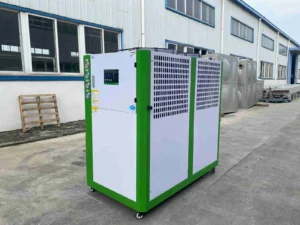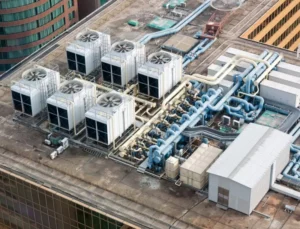In the rapidly developing industrial environment of modern times, industrial chillers, core components of refrigeration systems, find significant importance. Be it manufacturing, food processing, health care services, or production of electronic equipment, enfriadora industrial ensures stable operation of different industrial processes due to their excellent performance and efficient cooling capacity. The three basic types of industrial chillers are further discussed below to help you better understand their operating principles and application scenarios, and also be in a position to choose the unit that will best address your needs.
Ⅰ. Air-Cooled Chillers
1. How It Works

The air-cooled industrial chillers are the most common type. A fan draws heat from the refrigerant and expels it to the surrounding air. Small and medium businesses prefer this kind of chiller because it has easy installation with low-maintenance costs.
2. Features and Advantages
Air-cooled chillers offer several benefits for industrial chiller applications:
- Energy efficiency, as they do not require cooling towers
- Lower installation and maintenance costs due to fewer components
- Flexibility in placement, since they do not need a water source
- Environmental benefits, such as water conservation and reduced carbon emissions
- Reliable operation with simple maintenance needs
- Quick installation and minimal use of interior space
3. Application Scenario
Air-cooled chillers serve a wide range of industries, especially where water conservation is important or environmental regulations are strict. Common uses include:
| Industria | Application Description |
|---|---|
| Commercial Buildings | Maintain comfort by regulating indoor temperatures in offices |
| Data Centers | Prevent overheating of servers and ensure optimal operation |
| Manufacturing Facilities | Support temperature-sensitive processes, such as chemical production |
| Industria alimentaria | Provide cooling for product safety and storage |
Ⅱ. Water-Cooled Chillers
1. How It Works
Water-cooled chillers use water from a cooling tower or other water source to remove heat from the refrigerant. This process makes them a popular choice for large-scale cooling needs. The refrigeration cycle begins with the compressor drawing in low-pressure refrigerant gas and compressing it. The high-pressure gas then enters the condenser, where water absorbs the heat and condenses the refrigerant into a liquid. The refrigerant cools after passing through the expansion valve and enters the evaporator. Here, it absorbs heat from the chilled water circuit and cools the process fluid. The cycle repeats, maintaining a stable temperature.
2. Features and Advantages
Water-cooled chillers use water as a cooling medium, extracting heat from the refrigerant through a cooling tower and dissipating it into the surrounding environment. Their key advantages include:
Efficient Cooling: Water conducts heat better than air, making water-cooled chillers more energy-efficient and efficient, even under high loads.
Stable Performance: They provide more consistent cooling, making them suitable for industrial processes requiring strict temperature control.
Wide Application: They are suitable for large industrial plants and achieve optimal performance as long as an adequate water supply is ensured.
3. Application Scenarios
Many industries rely on water-cooled chillers for critical cooling tasks. Some common uses include:
- Manufacturing and industrial cooling: Keeps machinery and production processes at safe temperatures.

- HVAC systems for commercial buildings: Regulate indoor climate in large offices and complexes.
- Industria alimentaria y de bebidas: Maintains proper refrigeration for processing and storage.
- Pharmaceuticals and laboratories: Delivers precise temperature control for sensitive materials and experiments.
Large-scale facilities often choose water-cooled chillers because they offer reliable cooling and energy savings, especially when high capacity is needed.
Ⅲ. Evaporative Condensed Chillers
1. How It Works
Evaporative condensing chillers are highly efficient refrigeration devices that combine the advantages of air cooling and water cooling. They utilize evaporative cooling technology to dissipate heat through latent heat of evaporation, achieving efficient heat exchange. These chillers are increasingly popular in industrial refrigeration due to their high energy efficiency, low operating costs, and ease of maintenance.
2. Features and Advantages
Evaporative chillers utilize heat sources (such as solar energy or waste heat) and specialized chemicals (such as lithium bromide) to drive the refrigeration cycle. Their key advantages include:
Energy Efficiency: Evaporative condensing units utilize the latent heat of evaporation, resulting in higher energy efficiency than traditional air-cooled chillers, significantly reducing energy consumption and operating costs.
Low Operating Costs: Compared to water-cooled chillers, evaporative condensing units eliminate the need for complex cooling towers and water treatment systems, reducing acquisition and maintenance costs.
Easy Maintenance: Their relatively simple design minimizes maintenance requirements and reduces long-term operating costs.
Wide Range of Applications: Suitable for medium to large industrial plants, they are ideal for areas with limited water resources and high ambient temperatures.
3. Application Scenarios
Many industries rely on evaporative condensed chillers for their cooling needs. These systems often appear in:
- Data centers, where they keep servers from overheating.
- Manufacturing plants, supporting temperature-sensitive processes.
- Power generation facilities help manage equipment temperatures.
- Pharmaceutical production, where precise climate control is crucial.
- Laboratories, ensuring stable conditions for experiments.
An industrial chiller of this type offers strong performance in places where water evaporates easily and the air stays dry.
Ⅳ. How to Choose the Right Industrial Chiller
Choosing the right industrial chiller requires considering multiple factors, including cooling requirements, budget, space constraints, and energy availability. Here are some key considerations when selecting an industrial water chiller:
- Application Needs: Each process has its own cooling requirements. The right chiller meets those needs without wasting energy.
- Size: Proper sizing ensures efficient operation and prevents overheating or undercooling.
- Location: Indoor and outdoor installations have different demands. Space and climate affect performance.
- Safety: Facilities with hazardous materials need chillers with strong safety features.
- Temperature Control Requirements: Some processes need precise temperature control for quality and safety.
- Cooling Fluid Compatibility: The chiller must work with the chosen cooling fluid to avoid damage.
- Electrical Specifications: Voltage and power requirements must match the facility’s infrastructure.
Ⅴ. Conclusion
Factors to consider when choosing an industrial water chiller include capacity, type of chiller, energy efficiency, brand service, and support. With the growing trends in technology, industrial chiller systems shall continuously be part of the inline production by offering stable temperature control solutions to all types of industries.

